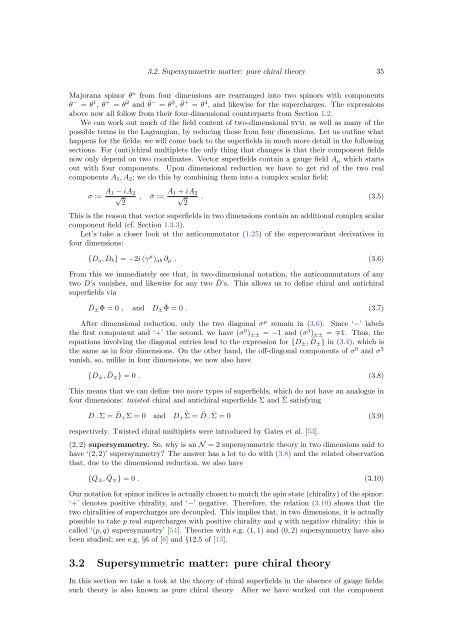The Bethe/Gauge Correspondence
The Bethe/Gauge Correspondence
The Bethe/Gauge Correspondence
Create successful ePaper yourself
Turn your PDF publications into a flip-book with our unique Google optimized e-Paper software.
3.2. Supersymmetric matter: pure chiral theory 35Majorana spinor θ a from four dimensions are rearranged into two spinors with componentsθ − = θ 1 , θ + = θ 2 and ¯θ − = θ 3 , ¯θ + = θ 4 , and likewise for the supercharges. <strong>The</strong> expressionsabove now all follow from their four-dimensional counterparts from Section 1.2.We can work out much of the field content of two-dimensional sym, as well as many of thepossible terms in the Lagrangian, by reducing those from four dimensions. Let us outline whathappens for the fields; we will come back to the superfields in much more detail in the followingsections. For (anti)chiral multiplets the only thing that changes is that their component fieldsnow only depend on two coordinates. Vector superfields contain a gauge field A µ which startsout with four components. Upon dimensional reduction we have to get rid of the two realcomponents A 1 , A 2 ; we do this by combining them into a complex scalar field:σ := A 1 − iA 2√2, ¯σ := A 1 + iA 2√2. (3.5)This is the reason that vector superfields in two dimensions contain an additional complex scalarcomponent field (cf. Section 1.3.3).Let’s take a closer look at the anticommutator (1.25) of the supercovariant derivatives infour dimensions:{D a , D b } = −2i (γ µ ) ab ∂ µ . (3.6)From this we immediately see that, in two-dimensional notation, the anticommutators of anytwo D’s vanishes, and likewise for any two ¯D’s. This allows us to define chiral and antichiralsuperfields via¯D ± Φ = 0 , and D ± ¯Φ = 0 . (3.7)After dimensional reduction, only the two diagonal σ µ remain in (3.6). Since ‘−’ labelsthe first component and ‘+’ the second, we have (σ 0 ) ±± = −1 and (σ 3 ) ±± = ∓1. Thus, theequations involving the diagonal entries lead to the expression for {D ± , ¯D ± } in (3.4), which isthe same as in four dimensions. On the other hand, the off-diagonal components of σ 0 and σ 3vanish, so, unlike in four dimensions, we now also have{D ± , ¯D ∓ } = 0 . (3.8)This means that we can define two more types of superfields, which do not have an analogue infour dimensions: twisted chiral and antichiral superfields Σ and ¯Σ satisfyingD − Σ = ¯D + Σ = 0 and D + ¯Σ = ¯D− ¯Σ = 0 (3.9)respectively. Twisted chiral multiplets were introduced by Gates et al. [53].(2, 2) supersymmetry. So, why is an N = 2 supersymmetric theory in two dimensions said tohave ‘(2, 2)’ supersymmetry? <strong>The</strong> answer has a lot to do with (3.8) and the related observationthat, due to the dimensional reduction, we also have{Q ± , ¯Q ∓ } = 0 . (3.10)Our notation for spinor indices is actually chosen to match the spin state (chirality) of the spinor:‘+’ denotes positive chirality, and ‘−’ negative. <strong>The</strong>refore, the relation (3.10) shows that thetwo chiralities of supercharges are decoupled. This implies that, in two dimensions, it is actuallypossible to take p real supercharges with positive chirality and q with negative chirality: this iscalled ‘(p, q) supersymmetry’ [54]. <strong>The</strong>ories with e.g. (1, 1) and (0, 2) supersymmetry have alsobeen studied; see e.g. §6 of [8] and §12.5 of [13].3.2 Supersymmetric matter: pure chiral theoryIn this section we take a look at the theory of chiral superfields in the absence of gauge fields;such theory is also known as pure chiral theory. After we have worked out the component
















